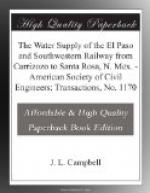A full pipe and a steady pressure are highly desirable. This doubtless accounts to some extent for the extreme tightness of the wood pipe in the pumping main.
Grade Lines.—The hydraulic grade lines, shown on Plate V, were laid as best fitting the controlling elevations. The various diameters of pipe were determined by Darcy’s general formula, with C = 0.00033 for wood and = 0.00066 for iron pipe, checking by Kutter’s formula, with n = 0.01 for wood and = 0.012 for iron. These coefficients were taken as conservative and on the safe side, and such they proved to be. It was desired that the line should carry not less than 5 sec-ft. to Nogal and half as much beyond.
Velocities.—The pipe line from Bonito Creek to the Nogal Reservoir affords excellent conditions for velocity and capacity measurements, there being no distribution service from it. Beginning at the creek, it consists of 12,700 ft. of 10-in. wood pipe, with a hydraulic grade of 0.03338, followed by 48,000 ft. of 16-in. wood pipe, with a hydraulic grade of 0.0030625, ending on the south rim of the Nogal Reservoir. There is an open stand-pipe where the two pipes and grades join.
When this section of the line was laid, the last car of 16-in. pipe was late in arriving and, as it was desirable to get water into the reservoir as soon as possible, 500 ft. of 10-in. pipe were laid in the lower part of the 16-in. line, near the reservoir, as indicated on Fig. 2, which shows the hydraulic grades and the pipe diameters of this section of the line.
When the first two velocity measurements, of March 10th and 31st, 1908, described below, were made (after the line had been put into service on February 20th, 1908), the 500 ft. of 10-in. pipe were still in the 16-in. line, and the hydraulic grade was defined by the solid line, ABCDE, Fig. 2.
When the third measurement, of May 12th, 1909, also described below, was made, the 10-in. pipe had been replaced by 16-in. pipe, and the hydraulic grade was defined by the solid line, ABE.
[Illustration: FIG. 2.]
The dotted line, AFE, is the approximate theoretical position which the grade, ABCDE, should have assumed when the 500 ft. of 10-in. pipe were taken out of the 16-in. line. On the contrary, it took the position of the grade line, ABE.
During the interval between March, 1908, and May, 1909, the water came to overflow from the stand-pipe at B, when the line was running under full pressure, indicating an increase of capacity in the 10-in. pipe greater than a corresponding increase in the 16-in. The alignment of the 10-in. line, vertically and horizontally, is more regular and uniform than the 16-in. line. The latter has many abrupt curves and bends, vertically and horizontally. It crosses nine sharp ridges and dips under as many deep arroyos. This introduces a fixed element of frictional resistance which does not decrease with the increasing smoothness of the interior surface of wood pipe, and probably accounts for the higher resistance of the 16-in. line.




